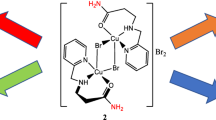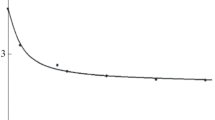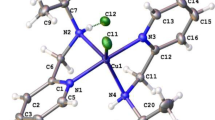Abstract
TRIVALENT chromium forms, with dibasic anions of oxygen-containing acids, complex ions of the type [Cr(AA)3]3−, in which the ligands are bound to the central atom through oxygen atoms. The best-known representatives of this group of compounds are trisulphatochromates(III)1,2 and complex anions with organic acids3, for example, with oxalic4,5 and lactic6 acid. The complex with lactic acid is the stable and relatively strong trilactatochromic acid H3[Crlact3]. The phosphite anion, which may also act as a bidentate oxoligand7, forms a similar triphosphitochromic acid H3[Cr(HPO3)3].
Similar content being viewed by others
References
Wernicke, W., Pogg. Ann., 159, 575 (1876).
Recoura, A., C.R. Acad Sci., Paris, 84, 1090 (1877); 112, 1439 (1891); 183, 719 (1926).
Shuttleworth, S. G., J. Amer. Leather Chem. Assoc., 44, 889 (1949).
Welo, L. A., Phil. Mag., (7), 6, 481 (1828).
Berghman, A. G., J. Russ. Phys. Chem. Soc., 56, 177 (1925).
Shuttleworth, S. G., J. Amer. Leather Chem. Assoc., 45, 447 (1950).
Ebert, M., and Podlaha, J., Coll. Czech. Chem. Com. (in the press).
Werner, A. A., Chem. Ber., 45, 3061 (1912).
Author information
Authors and Affiliations
Rights and permissions
About this article
Cite this article
PODLAHA, J., EBERT, M. Triphosphitochromic Acid. Nature 188, 657–658 (1960). https://doi.org/10.1038/188657b0
Issue Date:
DOI: https://doi.org/10.1038/188657b0
- Springer Nature Limited
This article is cited by
-
Iron (III) tris(monohydrogen phosphito) chloride—a novel complex
Experientia (1982)





